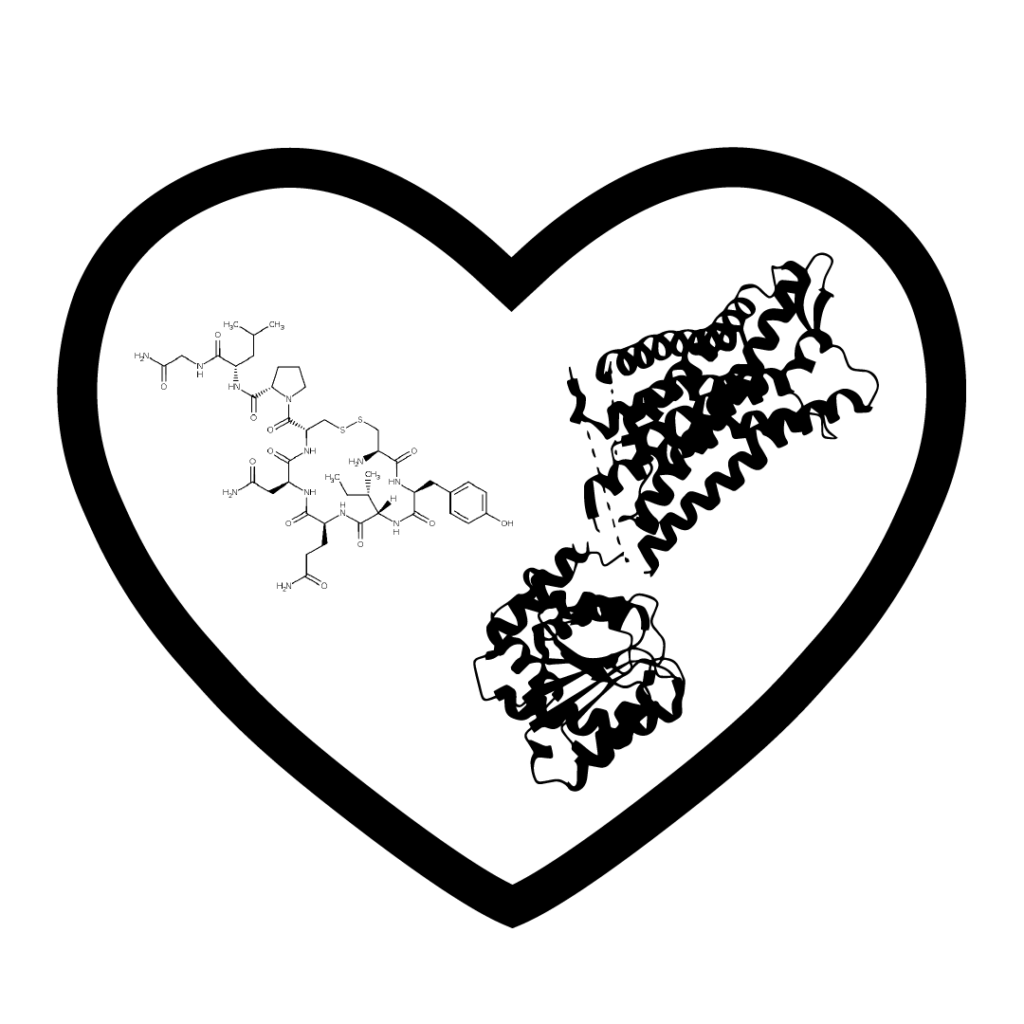
Oxytocin (left) and the oxytocin receptor (right, not to scale, Waltenspühl et al 2020)
On Valentine’s Day of all days, it’s probably not wise to wax too scientific about the biology of love. Nonetheless, proteins and the proteome have a lot to teach us when it comes to romance. In this blog post, we spitball a few ways comprehensive proteomic analysis can help us understand the complexities of love and its effects.
Oxytocin – the love hormone?
There are many different kinds of love and it’s not always clear what people are talking about when they say, “I love you.” There’s platonic love – love between friends, familial love – love between family members, lust – purely physical/sexual attraction, and, of course, romantic love – intimate love between partners. More confusing still, there are many components to love like attraction and sustained affection as well as different hormones, neuronal connections, and biological signaling pathways. Katherine Wu does a great job distilling some of the science behind love here.
Interestingly, one hormone that you see popping up again and again in many facets of love is oxytocin. This peptide, or small protein, plays roles in arousal, aggressiveness, parental affection, bonding, lactation, birth, and much more. Below we discuss some of the experiments one could do to learn more about oxytocin, occasionally called “the love hormone,” using a comprehensive proteome analysis platform like that being developed at Nautilus.
Love letters between cells – giving and receiving oxytocin
The oxytocin peptide is encoded in a gene called OTX. The peptide is mainly produced by cells in the brain and, to a lesser extent, other parts of the body. After production, it may be distributed throughout the body through the blood stream or may act locally on neurons and neuronal pathways in the central nervous system.
Oxytocin binds to cells that produce a particular receptor protein creatively called “the oxytocin receptor,” and binding results in changes to a variety of biological signaling pathways that can alter neuronal activity, gene expression, muscle activity, cell growth, and other processes. Ultimately, these activities can change organismal behaviors (see Jurek and Neumann 2018 for a thorough review).
Many studies have measured which cells in which parts of the body produce oxytocin or the oxytocin receptor, but a comprehensive proteomics platform could provide far more context to the diverse roles this hormone and its receptor play in specific behaviors.
For example, if one were trying to discover why oxytocin signaling in one set of cells facilitated arousal, while in another set of cells it lowered aggressiveness, one could use a proteomics platform to see what other proteins are expressed in these differentially responsive cells or tissues. If one consistently found a particular set of proteins was associated with one behavior, those proteins might just be required for the ultimate behavior.
Continuing the romance – downstream responses to oxytocin
In addition to discovering the cellular contexts required for certain behaviors, one could also use proteomics to discover which proteins carried out those behaviors. Oxytocin can change the production of many proteins in cells that receive it. Proteomics platforms can give scientists a clear picture of what happens to functional protein levels in cells that respond to oxytocin. Researchers can later do experiments to determine which of these proteins are most necessary for the behavioral changes observed.
Battling anxiety through the power of love?
Hopefully you’ve experienced a decrease in anxiety after receiving affection from a beloved human or pet. Oxytocin may play a role in this decreased anxiety, and many have begun to test whether they can treat anxiety and other disorders with oxytocin.
Given oxytocin’s role in so many different behaviors, the results of an oxytocin therapy could be highly dependent upon how this hormone or drugs that mimic it are administered and which cells they interact with (see Erdozain and Peñagarikano 2020 for a review covering issues surrounding oxytocin’s effectiveness in clinical trials). If researchers use proteomics technologies to determine which protein changes are necessary for the anti-anxiety effects of oxytocin, they could use this information to design better anti-anxiety drugs in a variety of ways including:
- Using cells in the lab, they could determine whether their drugs alter protein levels in the same way oxytocin does before administering the drugs to patients.
- They could identify which proteins downstream of oxytocin would be best to target to more specifically lower anxiety without impacting other behaviors influenced by oxytocin.
Such studies could lead to less anxiety for all and not just those who have a special someone on Valentine’s Day.
Love is complicated
While you’ve been reading this post, you may have been screaming “LOVE IS MORE COMPLICATED THAN OXYTOCIN!” In doing so, you would be 100% correct. As a recent NPR article states, “There’s more to love than a single hormone.” Indeed, there are many more facets to even oxytocin biology than we could get to here, and the science is far from settled. Nonetheless, we hope this post shows you that, with topics as complicated as love, novel proteomics platforms can lead to a much-improved understanding and great benefits for all.
Happy Valentine’s Day!
MORE ARTICLES


